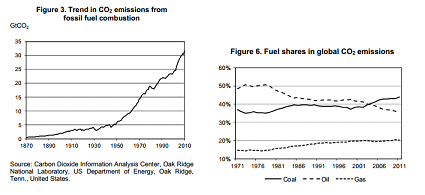The GTCC power plant is a more efficient way to use natural gas, but it is also important to consider less obvious costs and benefits of this technology.
Global Climate Change and Environmental Pollutants:

The above figures from the Energy Information Association (EIA) show that nationally, combustion of natural gas consistently emits less carbon dioxide (a major environmental pollutant) than combustion of coal. Considering that GTCC power plants are even more efficient than traditional gas power plants, this means that increased implementation of GTCC technology will result in even further reductions of carbon dioxide emissions. Since the EIA states that production of natural gas has increased in recent years, more gas will be available to support development of more GTCC power plants, resulting in more energy production with less pollution. Combined with other modern emission reducing technologies. In future years we can expect to see either constant or reduced emissions, even with increasing energy demand.

Carbon dioxide emissions are important because they are one of the more prevalent green house gasses. According to the International Energy Agency (IEA), carbon dioxide is a major factor in positive radiative forcing, which in tern adds to climate change. Climate change is the phenomenon that describes the slowly increasing global temperature, melting the ice caps causing sea level rises. In addition, carbon dioxide has a very long lifetime in the atmosphere, so reducing emissions now may only have appreciable effects centuries later. As seen in the figure above, carbon dioxide emissions from fossil fuel consumption have increased, and natural gas is contributing more and more to these emissions. Implementing GTCC plants is therefore essential to reduce the emissions and harmful effects of carbon dioxide.
Cost of GTCC Plants and Economic Development:

Since GTCC plants are more complex than traditional natural gas plants, it appears as though GTCC plants would be more expensive to build. However, since a GTCC plant is more efficient than a traditional gas power plant, the savings from resource cost would payback this initial costs in a matter of years. According to the EIA, natural gas spot (wholesale) prices have been low in past years and are decreasing this year (please see above figure). This provides two incentives for the development and construction of new GTCC plants. First, construction of the plant will be expensive, but fuel will initially be cheap, so the plant will be able to recover financially. Second, if fuel prices increase, the more efficient GTCC plant will need to purchase less fuel than a traditional plant, leading to economical savings.
Fracking and the Energy-water nexus:
Natural gas is certainly a useful resource, but one of the major technical challenges of using it is being able to extract natural gas from deep underground deposits. Shale gas has proven to be particularly difficult to extract due to the low permeability of the shale (the rock surrounding the gas) and the depth at which it must be extracted. However, as shown in the figure below, the Energy Information Administration tells us that shale gas is expected to provide an increasing amount of our energy (and therefore electricity) supply thanks to new mining techniques such as fracking.

Fracking is a process by which water, sand, and various chemicals are pumped into a pre-drilled well. This well is drilled vertically until it reaches the depth of the shale. at which point it is drilled horizontally. The water, sand, and chemicals enter this horizontal section and exert great pressure , causing the surrounding shale to crack, causing the natural gas in the shale to flow up the well, where it is captured and stored in large tanks.
The main issues with fracking concern water use before, during, and after the fracking takes place and the ecological damage to the surrounding areas. According to the Energy Information Association, the first concern is the massive amount of water required in fracking operations. Local freshwater supplies and wildlife can therefore be adversely affected if too much water is diverted to fracking. During operations, if fracking fluid leaks from wells or the pumping site, it can quickly pollute the site and any areas around it. Finally, after fracking, contaminated water is often stored in open-air pits before treatment. These pits can leak and spill their contents into the environment. A current way to fix this is to deposit the waste water into deep underground wells or aquifers, where it cannot seep out. Dated policy prevents the enforcement of adequate maintenance, and a number of incidents have occured.
Resources:
CO2 Emissions From Fuel Consumption Highlights. International Energy Agency, 2013. Web. 04 May 2014.
Issues and Trends: Natural Gas. US Energy Information Administration, 16 Jan. 2014. Web. 04 May 2014.
What is shale gas and why is it important? U.S. Energy Information Administration, 5 December 2012. Web. Accessed 12 April 2014.
Primary Author: Eric Gallant
Editor and Secondary Author: Justin Sandler